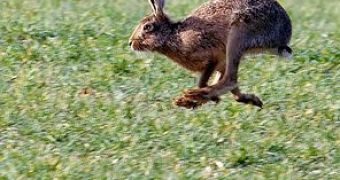Scientists confirmed that European brown hares can develop a second pregnancy before delivering the previous litter is not delivered, and this mechanism increases their reproductive success by one third.
The superfetation or superconception phenomenon was finally confirmed by researchers of the Leibniz Institute for Zoo and Wildlife Research (IZW) in Berlin, Germany.
They used high resolution ultrasonography in live female European brown hares, or Lepus europaeus, and confirmed that a second pregnancy occurred while the female was already pregnant.
They carried out experiments on a captive colony of hares, and found out that the ovaries of hares close to giving birth contained active corpora lutea from a first pregnancy as well as a second set that indicates a second pregnancy at the same time.
Corpora lutea are a yellow, progesterone-secreting mass of cells that forms from an ovarian follicle after an ovulation and produce progesterone, the pregnancy hormone.
Female hares only ovulate after copulating with male hares, and in the late pregnancy period, it is the female who initiates copulation.
Researchers fertilized the European brown hares during pregnancy and they developed a second pregnancy four days before the first delivery, explaining why after giving birth, the new embryos were already four days old.
This way, the interval between two successive litters is of 38 days instead of at least 42 days, as it would normally be in hares.
Dr. Kathleen Roellig, scientist and veterinarian at the IZW said that what was “new in our study was the collection of data using the latest examination technique in living females.
“Therefore we examined female hares repeatedly using high-resolution ultrasound to make the 'invisible visible' “, she says.
Thanks to this method, scientists managed for the first time to prove superfetation in living individuals, AlphaGalileo reports.
This ability allows female hares to deliver up to one third more offspring each reproductive season.
For this reason, Roelling suggested “that superfetation might be an evolutionary adaptation to increase the reproductive success,”
The results of this research are now published in the latest issue of the scientific journal „Nature Communications“.

 14 DAY TRIAL //
14 DAY TRIAL //